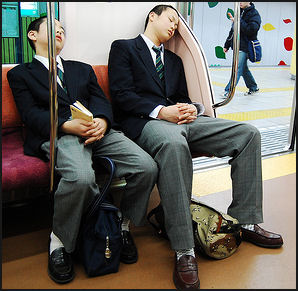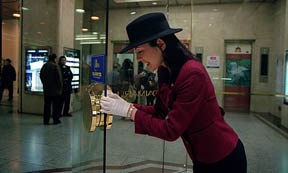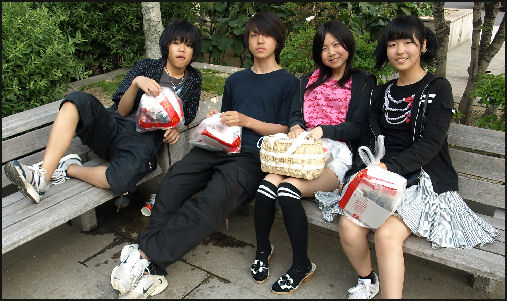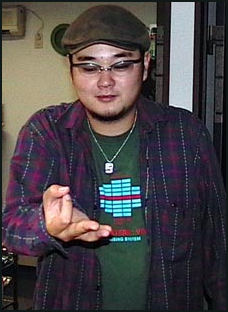JAPANESE CUSTOMS, MANNERS AND ETIQUETTE

sleeping on the subway Westerners have a hard time figuring out all the customs and formalities in Japan: where and when to take off one's shoes; what kind of gift to bring to what kind of occasion; and what kind of duties are required to be a good neighbor, a good coworker and seat-mate on a train.
Japanese can be quite the sticklers for details when it comes to etiquette. For example it is considered better to give an old person an umbrella for a present than a watch or cash, and it is better to wait a couple days before sending a RSVP for a wedding you can’t attend because to reply immediately would suggest that you didn’t try very hard to fit the wedding into your schedule. Women wearing pearls to a funeral should not wrap them around their neck twice because this suggests that misfortune will double up. Don't worry too much, though. Westerners aren't expected to know all Japanese customs and if mistakes are made or a custom is forgotten it usually is no big deal.
On things to love about Japan, Andrew Bender wrote in the Los Angeles Times: “1) Bowing. I often have my first experience before takeoff from LAX, when the entire cabin crew aboard the JAL flight bows in unison before the safety announcements. This collective gesture of welcome and appreciation is repeated everywhere: from the attendants putting you on the limousine bus at the airport to the staff of the ryokan (inn) as you check out. 2) Hospitality. It must be an unwritten law that ryokan room attendants are prohibited from saying, "No." When I've offered to carry suitcases that seem bigger than the bell clerk, my offers are routinely and politely declined. All this, and never a thought of a tip. [Source: Andrew Bender, Los Angeles Times, March 11, 2012]
The younger generation is also losing their grasp of basic manners and etiquette. Some university require their students take etiquette classes in which they are told things like refrain from using a cell phone while riding a bike and don’t eat noodles while walking down the street. At one university in Akita Prefecture students are prohibited from dying their hair and piercing their bodies. Monitors regularly walk around the school to make sure the rules are followed.
Links in this Website: JAPANESE CUSTOMS Factsanddetails.com/Japan ; SOCIAL CUSTOMS IN JAPAN Factsanddetails.com/Japan ; JAPANESE HOME, EATING AND DRINKING CUSTOMS Factsanddetails.com/Japan ; JAPANESE PERSONALITY AND CHARACTER Factsanddetails.com/Japan ; JAPANESE POLITENESS AND INDIRECTNESS Factsanddetails.com/Japan ; JAPANESE SOCIAL LIFE Factsanddetails.com/Japan ; JAPANESE SOCIETY Factsanddetails.com/Japan ; JAPANESE REGIONAL DIFFERENCES Factsanddetails.com/Japan
Good Websites and Sources: Japan Guide japan-guide.com ; Japanese Manners and Etiquette thejapanfaq.com/FAQ-Manners ; Ten Japanese Customs /matadorabroad.com /matadorabroad.com ; Culture- at-Work culture-at-work.com ; Executive Planet executiveplanet.com ; Kwintessential kwintessential.co.uk; Books: “The Traveler's Guide to Asian Customs & Manners” by Elizabeth Devine and Nancy L. Braganti. “Kata: The Guide to Understanding and Dealing with the Japanese!” By Boye Lafayette De Menter (Tuttle, 2003). Sources for advise on Japanese and international etiquette include Mary Kay Metcalf of Creative Marketing Alliance in New Jersey and Chicago-based Japan Intercultural Consulting.
Eating and Drinking Customs: Essential Japanese Guide essential-japan-guide.com ; Sushi Etiquette homepage3.nifty.com ; Right Way to Eat Sushi snippets.com ;Drinking Customs japanvisitor.com ; Bathing Customs Rituals and Etiquette at Japanese Public Bath Fabulous Travel ; Bathing Etiquette sentoguide.info
Japanese Greetings
Japanese have traditionally been wary of introducing themselves to strangers. They generally hang out with people only within their groups and find interacting with strangers to be stressful, requiring a certain amount of forwardness they are uncomfortable with. For this reason introductions are usually made with the help of an intermediary, common friend or a third party.
“ Aisatsu” is Japanese word that is often translated as “greeting” but in actuality is much broader, more all-encompassing and important than its translation suggests. Long books have been written about it or different aspects of it. Aisatsu covers a range of behaviors and sayings that people use in a variety of situations and includes speeches and public remarks. To avoid coming off as foolish or ill-bred one has to have proper aisatsu. Parents often say that it is one of the most important thing for their kids to learn in day care or kindergarten.
Names and Titles in Japan
People should be addressed by their titles and their family names plus an honorific (usually "san"). Using first names is considered presumptuous, too familiar and rude. Honorifics have their roots in the Middle Ages when they were strictly based on social hierarchy. After World War II when Japanese society became more democratized they were used in accordance with level of intimacy between speakers.
Japanese should ideally be addressed by Westerners with Mr., Mrs., Miss or by adding the suffix “"san"” to the last name. Japanese use the suffix san even with neighbors and friends they have known for years. Some young or Americanized Japanese are comfortable being addressed by their first names or an English nickname.
Common titles include “sensei” (teacher or professor), “oishasan” (doctor), “untenshusan” (taxi driver), “omawarisan” (policeman). Within companies people are often addressed by their titles — chairman, president, manager, section manager, supervisor, etc.”rather than name. The teacher Aya Nakamura is called Nakayamura-san (Ms. Nakamura) by her boss and Nakamura Sensei or Sensei by her students. Some of her friends might call her Aya-chan. "Chan" is a suffix usually used with the first names of children, good friends and sometimes with dogs or other pets.
In addressing someone in the second person, Japanese have traditionally had to take into account age, circumstance, gender, social position and other factors to decide which verb endings, adjectives and words to use. This is not as true today with the exception of people using more respectful language when talking to older people or addressing people in formal situations.
Attitude in Japan Towards Names and Titles
Breaches of name and title etiquette can sometimes have deadly consequences. In 1975, two workers with the Elpida Company — 30-year-old Kunihiro Fukada and 27-year-old Tomohiko Okabe — were having a drink at a bar in Tokyo. Even though Okabe was younger than many of his co-workers he often addressed co-workers that were older than him with language used for people younger because he entered the company earlier them. He did this with Fukada. Fukada took offense and Okabe said, “What’s wrong if a senior guy calls his junior in this way?” Outraged. Fukada grabbed Okabe’s neck, pummeled his face and killed him.
Over time Japan has become less formal. Some companies have even issued orders to their employees to stop addressing one another by their titles but to simply add the suffix -san to their names. Parents and teachers no longer expect their children to use honorific language. Many older Japanese see the change as a coarsening of their language and society.
Japanese Bowing

department store bow The Japanese bow to one another as a greeting, a parting gesture, a way of expressing humility, respect or apology, and an alternative to waving or saying "Hi." The Japanese often bow every time they meet someone, even if they have already seen that person several times that day. Sometimes they even bow to each other while they are riding bicycles.
When bowing, hands should be placed on the sides of the legs above the knees. Feet should be together. Don't bow more for than a couple of seconds except when praying. Sometimes Japanese bow slightly to one side so they don't bump heads with the person they are bowing to.
Bows are carefully calibrated to show different levels of respect. A short, clipped bow of about 20 degrees is used for service people or acquaintances. This bow should last no more than a second. A slower, deeper bow is used for one's boss or department head. The deepest bows are reserved for the company president or member of the board of directors. If people of unequal status bow the lower-ranking person should bow more deeply than the higher-ranking person.
News broadcasts generally begin and end with a bow. Welcome girls at Japanese department stores greet every customer with a bow. A columnist with a Tokyo newspaper once calculated that an average welcome girl bowed 665,600 times a year if she worked a five day work-day and 798,720 times if she worked six days.
To be polite bow as low or lower than the person you are bowing to. It is also a good idea to lower your eyes and keep you hands and fist unclenched against your side.
Japanese often say “bye bye” when parting. Some kids keep saying by “bye bye” repeatedly, over and over, for a long time, when they say goodbye to their friends. They do this because they like their friends so much and are sad to see them go.
Dogeza, the Power of a Very Deep Bow
A “ dogeza “ is a formal apology or request that involves making a very, very deep bow or even kneeling down on the ground. Kanta Ishida wrote in the Daily Yomiuri: Dogeza is a rule of decorum that is peculiar to Japan, and is exemplified in phrases such as "losing is actually winning," "you win when you say ‘sorry'," and "you win when you do away with pride." But nowadays, the word's meaning no longer evokes the same lofty principles. Dogeza diplomacy, for example, refers to token diplomacy.” [Source: Kanta Ishida, Daily Yomiuri, April 1, 2011]
On a manga called “ Dogesen “, Ishida wrote: “The manga, by Keisuke Itagaki & Rin, revolves around a gentle, effeminate high school teacher named Hajime Seto. There is very little at which he excels. In fact, he has only one strength — an unbeatable one at that: dogeza.... For example, in an attempt to free a sex worker from her yakuza pimp, Seto performs the low bow in the middle of a pedestrian scramble crossing, pressing his head to the road. Seto's alarmingly resolute attitude — which goes far beyond mere subservience — overwhelms and deflects the yakuza. Accompanying his actions is the following narration: “Dogeza. The ultimate form of attachment to life; it is an act of begging for life, of craving life.”"
“Amazing. I was impressed that somebody decided to turn this theme into a manga. Itagaki, who writes this story in full partnership with mangaka Rin, is best known for his work in the world of combat sports manga, through titles such as Baki the Grappler or Garoden, which he wrote based on the story by Baku Yumemakura. In his previous works, Itagaki has focused on the idea of strength to the point of absurdity. Though Rin is credited with the artwork for Dogesen, the style is very much in that of Itagaki, leaving many readers wondering if Itagaki is in fact illustrating the series. Perhaps Dogesen is actually Itagaki's own attempt at suddenly seeking a way to express a world of weakness or nonviolence....But the philosophy behind Dogesen, that survival itself is a form of winning, even if you have to lose face to do it, gives me a sense of courage.”
Public Customs in Japan
Two of the most useful expressions in Japan are “gomen nasai” (“I’m sorry”) and “sumimasen” (“excuse me”), which can be used in almost any situation.
Polite Social Behavior in Japan
When offering a book or paper to someone older than you, you should show respect by using two hands to present the object. On a crowded subway or bus, you should give up your seat to elderly people, pregnant women and women with small children
When something is dropped in a park or along a trail the person who finds hangs it on a branch or a fence so it can easily be spotted,
Papers, notebooks, jackets and possessions are carefully handled, carefully placed somewhere and carefully handed from one person to the next — and not handled carelessly or tossed about as is the case sometimes sin the United States. To do would be rude and disrespectful.

Japanese teenagers
Impolite Social Behavior in Japan
Japanese consider it rude to look someone directly in the eye, cross your arms or legs, or have your hands in their pocket when you are speaking to them. Japanese usually focus their eyes on the lower neck of the person they are talking to and try to avoid staring.
Blowing your nose in public in considered highly offensive. If you have the sniffles or are stuffed up, it is best to excuse yourself and blow your nose in a rest room. Yawning loudly and chewing gum in public are also considered rude.
Tossing a wadded up napkin on the table or unfolded blanket on an airline seat is considered inconsiderate. The Japanese always carefully fold their napkins, blankets and even gum wrappers before discarding them. Even so young people sometimes thoughtless throw their wrappers and plastic bags on the ground.
Many Japanese expect subway cars, when they are not crowded, to be quiet, mellow places for sleeping. They don't like people who talk on cell phones or have loud conversation. Nor do they like women who put on make-up or young people who eat and drink, Many men read dirty magazines on a train in full view of female passengers..
Sitting in a desk is bad manners, Eating while walking on the streets is a custom still regarded with contempt by old-timers. Putting on make up in public is looked down upon as is brushing one’s teeth in public. Many people sit in priority seating set aside for elderly people and pregnant women and then don’t give up the seat when an elderly person or pregnant woman shows up.
Some Japanese respond violently over bad manners. In the mid-2000s a 28-year-old male high school teacher was arrested for striking a women on the head for her for crossing her legs on a train and brushing his leg with her foot and not appropriately apologizing. A police was reprimanded for pulling the hair of a young woman for talking on her cell phone on a train.
Displays of Affection in Japan

Asian couples don't usually express affection towards each other in public. Public displays of affection between members of the opposite sex’such as kissing, hugging and holding hands — are considered rude. Even families rarely touch, hug or display physical affection in public. Most school children have said they have never seen their parents kiss.
Holding hands and hugging among members of the same sex is perfectly acceptable although this practice is less common in Japan than other Asian countries. It is not unusual for a pair of women to walk down the street holding hands or for men to embrace one another and arm.
It has traditionally been considered taboo to touch the nape of a girl's neck. After World War II, kissing wasn't allowed in Japanese films. The first celluloid kiss took place in 1946 and the actors that did it were so nervous about it they put a piece of gauze between their lips.
Japanese couples are starting to kiss more in public. Young people can be seen embracing in the parks and wives sometimes kiss their husbands goodbye at train stations. One Japanese baseball team even offered reduced rate tickets to anyone who was willing to kiss outside the box office.
Japanese Gestures

In Japan, head nodding means you are paying attention but not necessarily agreeing. A sharp downward thrust of the head signifies “yes.” A hand in karate chop position before the face means "I'm sorry." A praying hands gesture in front of the face is a slightly more meaningful “I’m sorry.” Crossing your arms vertically means “stop.” Japanese like to flash “V” signs or twirl their fingers in their cheeks when they have their picture taken. Japanese women often wave with their fingers spread apart and jerky back and forth arm motions. The Japanese also have unique, jerky ways of pointing and making motioning gestures
Some Japanese shake one hand from side to side in front of their face to mean "no.” Others point to their nose to mean "me." Others still, point with their middle finger without realizing that it has a vulgar meaning in the West (many however know what it means). The Western "okay" hand signal means money. If someone asks a Japanese guy what he is doing tonight and he sticks out his pinkie finger it means he is going to be with a girl. Women regard this gesture as crude.
It is rude to point or gesture to someone to "come here" with your finger. Japanese sometimes gesture to children, taxis or waiters to "come here" by holding their palm down and shaking their hand up and down, but it is considered very rude to do this to an older person. The most polite way to attract someone's attention is make eye contact and bow slightly.
Shaking your hand by the side of your face means gay. A raised little finger means woman.
Smiling, Laughing and Sleeping in Japan

sleeping on the back of a bike Many Japanese laugh, smile or giggle when they are embarrassed or make a mistake rather apologizing or making an excuse. They don't mean to be rude. A smile is regarded as way to escape an uncomfortable situation. A laugh is regarded as a kind a apology. If you laugh along with them it means that you accept the apology. Japanese also sometimes smile when discussing sad topics because it is considered inappropriate to express private sadness.
Another reason that Japanese are reluctant to laugh openly is that they have a great fear of being laughed at and they don’t want to appear rude and laugh at somebody else. Alfons Deeken, a sociologist at Tokyo University, told the Washington Post, "Especially older people were taught to laugh was not to be serious. It is too frivolous. And to be frivolous is to lose face. Everyone is told as a child you are not to lose face."
Sometimes Japanese close their eyes when they are listening. They are not asleep. They are thinking. Sometimes they are pretending they are thinking but actually sleeping.
Japanese like to carefully fold things. Kids carefully fold their jackets when they set them down. People often fold other chopsticks covers, napkins and other tars before throwing it away.
Mastering Japanese Manners
Yumi Miyaki wrote in the Yomiuri Shimbun: "Seiza"--kneeling on a tatami mat--and then standing in the appropriate manner from that position immediately indicates you have a deep knowledge of Japanese etiquette. Men in particular seem to be unaware of the etiquette or find it difficult to learn the style.Tamami Kondo, an expert on Japanese etiquette, says, "Men tend to have less opportunities to learn manners than women." [Source: Yumi Miyaki, Yomiuri Shimbun, January 27, 2012]
One of the most important aspects of Japanese etiquette is the "me-sen," or eye level. Japanese people often refer to eye levels to define relationships. For example, "me-ue" (above eye level) means a higher ranking person, while "me-shita" (below eye level), refers to someone with a lower social standing. Kondo, who founded the Seishikai Manner Academy in Tokyo in 1977, outlines the importance of me-sen using as an example entering a room to meet with your boss and client, who are already seated. She warns against opening the sliding door slightly and glancing inside because it is rude as it would involve looking down at the two seated persons.
"[The best way] is to look down at your hand while quietly opening the door," Kondo says. This will naturally lower your eye-level and appear polite. When walking into the room, drop your eyes slightly instead of looking straight ahead. For the greeting, don't bow while standing because this again would involve looking down at your sitting boss and client. Instead, drop to your knees, place your hands on your thighs, slide your hands forward and then place your fingertips on the floor just in front of you. They should rest just in front of your knees. This posture will naturally cause you to bow slightly, showing respect to the people you are facing.
Kondo says to hold the posture and make a polite greeting such as "Osewa ni natte orimasu" (Thank you). To bow, do it deeply by sliding your hands further forward, putting your palms on the floor, and keeping your head and back straight. Avoid raising your hips as you move into this position, a common mistake among men.
If leaving to go to the bathroom or to make a phone call, Kondo says it is important to "stand up elegantly from a sitting position." Many men rise by sliding their legs sideways from their body or by bending a knee forward--both of which are considered bad form. To correctly get up from the sitting position, ensure that you keep your balance as you put your weight on your toes, slide your dominant leg slightly forward and stand.
Japanese etiquette was developed during the era of the samurai, when strict relationships between superiors and subordinates were a key part of class-based societies. The tradition has been passed from generation to generation, but some people today may find its practice cumbersome. "The idea behind Japanese etiquette is to use actions to express your deep feelings for other people," Kondo says. "As long as you acquire the basics, you can act with grace and confidence, while those around you will treat you with respect."
Image Sources: Hector Garcia, Ray Kinnane, Japanese gestures
Text Sources: New York Times, Washington Post, Los Angeles Times, Daily Yomiuri, Times of London, Japan National Tourist Organization (JNTO), National Geographic, The New Yorker, Time, Newsweek, Reuters, AP, Lonely Planet Guides, Compton’s Encyclopedia and various books and other publications.
Last updated June 2019
